
William I was a Prince of Orange, the King of the Netherlands and Grand Duke of Luxembourg.
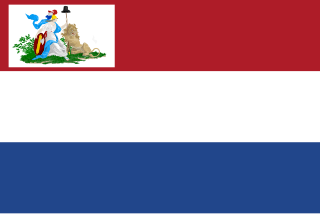
The Batavian Republic was the successor state to the Republic of the Seven United Netherlands. It was proclaimed on 19 January 1795 and ended on 5 June 1806, with the accession of Louis Bonaparte to the Dutch throne. From October 1801 onward, it was known as the Batavian Commonwealth. Both names refer to the Germanic tribe of the Batavi, representing both the Dutch ancestry and their ancient quest for liberty in their nationalistic lore.
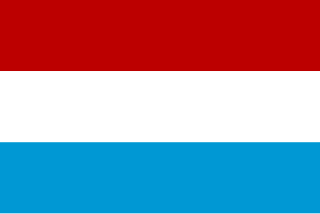
The United Provinces of the Netherlands, officially as the Republic of the Seven United Netherlands, and commonly referred to in historiography as the Dutch Republic, was a confederation that existed from 1579, during the Dutch Revolt, to 1795. It was a predecessor state of the Netherlands and the first fully independent Dutch nation state.
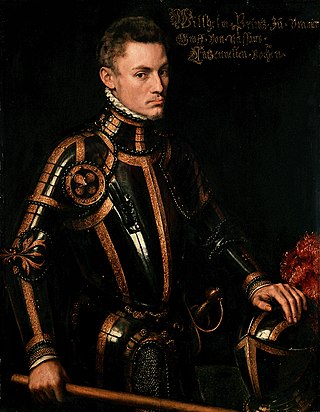
In the Low Countries, stadtholder was an office of steward, designated a medieval official and then a national leader. The stadtholder was the replacement of the duke or count of a province during the Burgundian and Habsburg period.
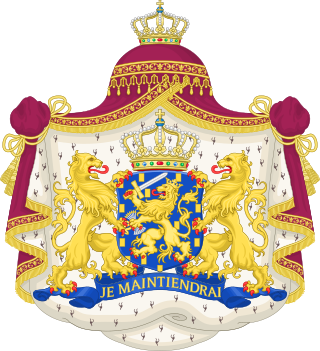
The House of Orange-Nassau is the current reigning house of the Netherlands. A branch of the European House of Nassau, the house has played a central role in the politics and government of the Netherlands and elsewhere in Europe, particularly since William the Silent organised the Dutch Revolt against Spanish rule, which after the Eighty Years' War (1568–1648) led to an independent Dutch state.

William V was a prince of Orange and the last stadtholder of the Dutch Republic. He went into exile to London in 1795. He was furthermore ruler of the Principality of Orange-Nassau until his death in 1806. In that capacity he was succeeded by his son William.

The Patriottentijd was a period of political instability in the Dutch Republic between approximately 1780 and 1787. Its name derives from the Patriots faction who opposed the rule of the stadtholder, William V, Prince of Orange, and his supporters who were known as Orangists.

Gijsbert Karel, Count van Hogendorp was a liberal conservative and liberal Dutch statesman. He was the brother of Dirk van Hogendorp the elder and the father of Dirk van Hogendorp the younger.
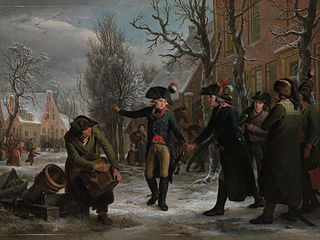
The Batavian Revolution was a time of political, social and cultural turmoil at the end of the 18th century that marked the end of the Dutch Republic and saw the proclamation of the Batavian Republic. The period of Dutch history that followed the revolution is referred to as the "Batavian-French era" (1795–1813) even though the time spanned was only 20 years, of which three were under French occupation under Napoleon Bonaparte.

In the 16th, 17th and 18th centuries, the regenten were the rulers of the Dutch Republic, the leaders of the Dutch cities or the heads of organisations. Though not formally a hereditary "class", they were de facto "patricians", comparable to that ancient Roman class. Since the late Middle Ages Dutch cities had been run by the richer merchant families, who gradually formed a closed group. At first the lower-class citizens in the guilds and schutterijen could unite to form a certain counterbalance to the regenten, but in the course of the 15th century the administration of the cities and towns became oligarchical in character. From the latter part of the 17th century the regent families were able to reserve government offices to themselves via quasi-formal contractual arrangements. In practice they could only be dislodged by political upheavals, like the Orangist revolution of 1747 and the Patriot revolt of 1785.

Louis Ernest of Brunswick-Lüneburg-Bevern was a field-marshal in the armies of the Holy Roman Empire and the Dutch Republic, the elected Duke of Courland (1741). From 13 November 1750 to 1766 he was the Captain-General of the Netherlands, where he was known as the Duke of Brunswick or Duke of Brunswick-Wolfenbüttel. Another brother was Duke Ferdinand of Brunswick who led the Allied Anglo-German army during the Seven Years' War.
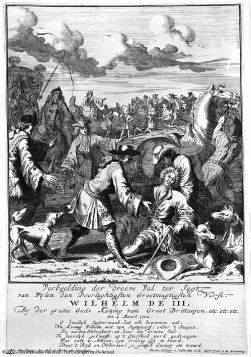
The Second Stadtholderless Period or Era is the designation in Dutch historiography of the period between the death of stadtholder William III on March 19, 1702, and the appointment of William IV as stadtholder and captain general in all provinces of the Dutch Republic on May 2, 1747. During this period the office of stadtholder was left vacant in the provinces of Holland, Zeeland, and Utrecht, though in other provinces that office was filled by members of the House of Nassau-Dietz during various periods. During the period the Republic lost its status as a great power and its primacy in world trade. Though its economy declined considerably, causing deindustralization and deurbanization in the maritime provinces, a rentier-class kept accumulating a large capital fund that formed the basis for the leading position the Republic achieved in the international capital market. A military crisis at the end of the period caused the fall of the States-Party regime and the restoration of the Stadtholderate in all provinces. However, though the new stadtholder acquired near-dictatorial powers, this did not improve the situation.

Friedrich Wilhelm von Thulemeyer or Frederick William von Thulemeier was born or baptized on November 9, 1735. He died July 6, 1811, also in Berlin. In 1763 he was sent by Frederick the Great as a diplomat in the Republic of the Seven United Provinces. In 1784/85 he was one of the architects of a trade relations between the US and Prussia. In 1788 he became justice minister under Friedrich Wilhelm II of Prussia. Of particular importance is - even today - his collection of music prints.

In the history of the Dutch Republic, Orangism or prinsgezindheid was a political force opposing the Staatsgezinde (pro-Republic) party. Orangists supported the Princes of Orange as Stadtholders and military commanders of the Republic, as a check on the power of the regenten. The Orangist party drew its adherents largely from traditionalists – mostly farmers, soldiers, noblemen and orthodox Protestant preachers, though its support fluctuated heavily over the course of the Republic's history and there were never clear-cut socioeconomic divisions.
Nassau-Orange-Fulda was a short-lived principality of the Holy Roman Empire from 1803 to 1806. It was created for William Frederick, the son and heir of William V, Prince of Orange, the ousted stadtholder of the abolished Dutch Republic after the Batavian Revolution of 1795.

The Prussian invasion of Holland was a Prussian military campaign in September–October 1787 to restore the Orange stadtholderate in the Dutch Republic against the rise of the democratic Patriot movement.
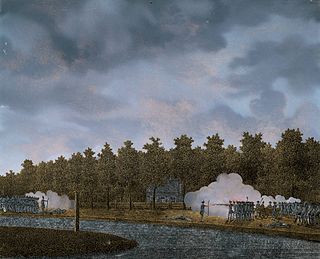
The Battle of Jutphaas, also known as the Battle of the Vaart or the Battle of Vreeswijk, occurred on 9 May 1787 on the banks of the Vaartsche Rijn canal near Jutphaas and Vreeswijk between Orangists and Patriots.
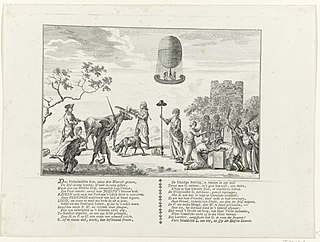
The Acte van Consulentschap was a secret, private contract between stadtholder William V, Prince of Orange of the Dutch Republic and his mentor and former guardian Duke Louis Ernest of Brunswick-Lüneburg, concluded on 3 May 1766, in which the latter was informally given continued powers of guardianship over the stadtholder in his private and public capacity. Not only gave this document the Duke a nefarious influence over affairs of state in the Republic, but when it became public in 1784 it caused such a scandal that the stadtholder's regime was almost fatally undermined in the political upheaval of the Patriottentijd.

The siege of Nijmegen occurred from 27 October to 8 November 1794 during the Flanders campaign of the War of the First Coalition. It was the last major military confrontation between the forces of the Revolutionary French First Republic and the reactionary First Coalition of European monarchs including William V, Prince of Orange, before the fall of the Dutch Republic in January 1795, which William had ruled as hereditary stadtholder since 1751. As commander-in-chief of the Dutch States Army, his indecision, several changes of mind and lack of coordination with his Anglo-Hanoverian, Hessian, Prussian and Austrian allies contributed to the eventual surrender of Nijmegen to the French revolutionaries.

The States of Friesland were the sovereign body that governed the province of Friesland under the Dutch Republic. They were formed in 1580 after the former Lordship of Frisia acceded to the Union of Utrecht and became one of the Seven United Netherlands. The Frisian stadtholder was their "First Servant". The board of Gedeputeerde Staten was the executive of the province when the States were not in session. The States of Friesland were abolished after the Batavian Revolution of 1795, when the Batavian Republic was founded. They were resurrected in name in the form of the Provincial States of Friesland under the Constitution of the Kingdom of the Netherlands.





















